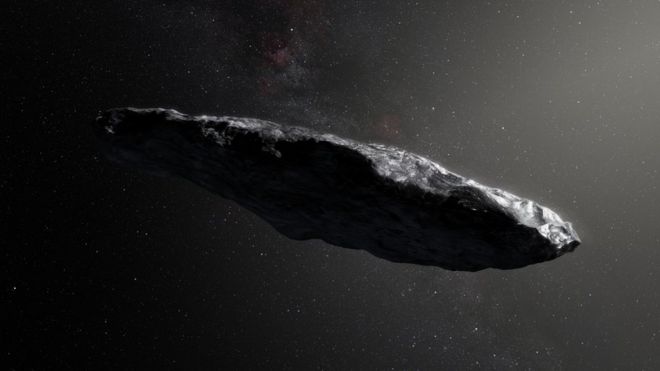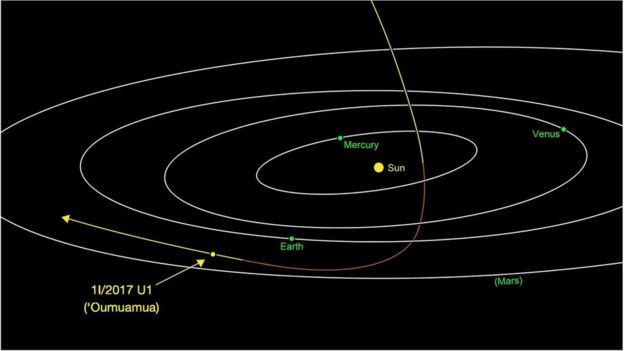
Object named Oumuamua now transiting our solar system. IF it is an alien artifact it's not good idea to bounce radio waves off it.

The eccentric trajectory of the object, i.e. out of the plane of the solar system, suggests it originated from outside our system - possibly another star.
By now millions of Earthers are aware of an extraterrestrial intruder having entered our solar system. In the shape of a mangled stogey, the thing designated as 1I/ 2017 U1 (aka Oumuaua) was detected as it sped towards the Sun on 19 October. Its orbital properties suggest it originated around another star, making it the first such body to be spotted in our cosmic neighborhood. More fascinating, its cigar-ish shape marks it as a potential alien artifact.
To wit, Yuri Milner's Breakthrough Listen program released a statement which read: "Researchers working on long-distance space transportation have previously suggested that a cigar or needle shape is the most likely architecture for an interstellar spacecraft, since this would minimize friction and damage from interstellar gas and dust."
In addition, we've learned from measurements that it has a dense structure and is comprised of rock and metal, but with little - if any - water-ice.
What about observations? Andrew Siemion, director of the Berkeley SETI Research Center, said: "'Oumuamua's presence within our Solar System affords Breakthrough Listen an opportunity to reach unprecedented sensitivities to possible artificial transmitters and demonstrate our ability to track nearby, fast-moving objects."
The first set of observations are to commence today at the Robert C Byrd Green Bank Telescope in West Virginia is due to last for 10 hours. These radio observations will be made across four different radio frequency bands. If passive "listening" is as far as it goes - no active bouncing of radio waves, i.e. transmissions off its surface -then that ought to be okay. But nothing more.
Stephen Hawking and others have already come out and warned if there is any chance of making ourselves known - revealed- to a much more technologically advanced civilization, we'd be wise not to do so. A nest of bugs happily ensconced in a corner of a home's kitchen won't have a very long life expectancy if the home owner finds them.
In 1978 the British Astronomer Royal, Sir Martin Ryle, pleaded for extreme caution in restricting any and all types of electromagnetic signals and noise emanating from our planet. He warned that it would be foolhardy to be anything but passive listeners given we don't know anything about alien intentions - should they receive a calling card from another world. Of course, Sir Martin likely based his cautions on a paper in the journal Science two years earlier, which showed how an advanced alien civilization could put together a detailed picture of life on Earth, especially of our defense capabilities.
Sir Martin may also have been reminded - as I am now with this object - of Sir Arthur C. Clarke's novel, Rendezvous with Rama - published in 1973. Set in the 2130s, the story involves a cylindrical alien star ship that enters Earth's solar system. Images obtained from unmanned spacecraft reveal that Rama is a perfect cylinder, 20 kilometers (12 mi) in diameter and 54 kilometers (34 mi) long, and almost completely featureless, making this humankind's first encounter with an alien spacecraft.
In a 1962 high school research paper, long before Hawking’s or Sir Martin's alien warnings emerged, I showed how any encounter with a truly advanced alien intelligence would likely be disastrous for the human race. While scifi films (e.g. 'Earth vs. The Flying Saucers') often painted the meetings or altercations in cartoonish terms, I reasoned a hostile future encounter was almost inevitable and that our (putatively) lesser civilization would fall to a much more advanced, alien one. It was impossible to avoid, and this may have been the basis of a 1960 Brookings Institution REPORT to that effect. (Which I cited in my paper)
Brookings Institution thinkers feared any contact with highly advanced aliens would trigger social, economic and religious upheaval - and collapse of civilization. The Brookings Institution's conclusions were largely based on the public reaction to the infamous Orson Wells' radio broadcast of "The War of the Worlds" and the local panic that ensued in 1938.
Let's also not forget that in 1972 - at a conference on potential interstellar contact- physicist Freeman Dyson warned that the first species we are likely to encounter is going to be technologically advanced and also highly aggressive - more likely to be predators than cosmic pals willing to share their techno secrets..
As one Brit astronomer put it to the BBC, this is all likely huff and puff and merely a strange shaped natural object, say asteroid. But if there's even a 1 in a billion chance it's really of alien origin, we'd be best to keep our encounter totally passive.
No comments:
Post a Comment